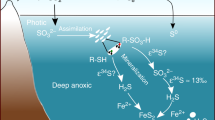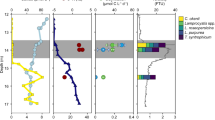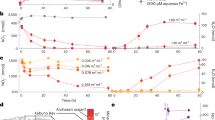Abstract
The production of organic precursors to life depends critically onthe form of the reactants. In particular, an environment dominated by N2 is far less efficient in synthesizing nitrogen-bearing organics than a reducing environment rich in ammonia (refs 1, 2). Relatively reducing lithospheric conditions on the early Earth have been presumed to favour the generation of an ammonia-rich atmosphere, but this hypothesis has not been studied experimentally. Here we demonstrate mineral-catalysed reduction of N2, NO2− and NO3− to ammonia at temperatures between 300 and 800 °C and pressures of 0.1–0.4 GPa — conditions typical of crustal and oceanic hydrothermal systems. We also show that only N2 is stable above 800 °C, thus precluding significant atmospheric ammonia formation during hot accretion. We conclude that mineral-catalysed N2 reduction might have provided a significant source of ammonia to the Hadean ocean. These results also suggest that, whereas nitrogen in the Earth's early atmosphere was present predominantly as N2, exchange with oceanic, hydrothermally derived ammonia could have provided a significant amount of the atmospheric ammonia necessary to resolve the early-faint-Sun paradox3.
This is a preview of subscription content, access via your institution
Access options
Subscribe to this journal
Receive 51 print issues and online access
$199.00 per year
only $3.90 per issue
Buy this article
- Purchase on Springer Link
- Instant access to full article PDF
Prices may be subject to local taxes which are calculated during checkout


Similar content being viewed by others
References
Schlesinger, G. & Miller, S. L. Prebiotic synthesis in atmospheres containing CH4, CO and CO2. I. Amino acids. J. Mol. Evol. 19, 376–383 (1983).
Stribling, R. & Miller, S. L. Energy yields for hydrogen cyanide and formaldehyde syntheses: the HCN and amino acid concentrations in the primitive ocean. Origins Life Evol. Biosph. 17, 261–273 (1987).
Sagan, C. & Chyba, C. The early faint sun paradox: organic shielding of ultraviolet-labile greenhouse gases. Science 276, 1217–1221 (1997).
Kasting, J. F., Eggler, D. H. & Raeburn, S. P. Mantle redox evolution and the oxidation state of the Archaean atmosphere. J. Geol. 101, 245–257 (1993).
Berndt, M. E., Allen, D. E. & Seyfried, W. E. J Reduction of CO2during serpentization of olivine at 300 °C and 500 bar. Geology 24, 351–354 (1996).
Tamaru, K. in Catalytic Ammonium Synthesis (ed. Jennings, J. R.) 1–18 (Plenum, New York, (1991)).
Holland, H. D. The Chemical Evolution of the Atmosphere and Oceans (Princeton Univ. Press, (1984)).
Frost, B. R. Stability of oxide minerals in metamorphic rocks. Rev. Minerol. 25, 469–483 (1991).
Johnson, M. C., Anderson, A. T. J & Rutherford, M. J. Pre-eruptive volatile contents of magmas. Rev. Minerol. 30, 281–330 (1994).
Javoy, M. & Pineau, F. The volatiles record of a ‘popping’ rock from the mid-Atlantic ridge at 14° N: chemical and isotopic composition of gas trapped in the vesicles. Earth Planet. Sci. Lett. 107, 598–611 (1991).
Summers, D. P. & Chang, S. Prebiotic ammonia from reduction of nitrite by iron (II) on the early Earth. Nature 365, 630–632 (1990).
Mancineli, R. L. & McKay, C. P. The evolution of nitrogen cycling. Origins Life Evol. Biosph. 18, 311–326 (1990).
Buresh, R. J. & Moraghan, J. T. Chemical reduction of nitrate by ferrous iron. J. Environ. Qual. 5, 320–325 (1976).
Knowleds, R. Denitrification. Microbiol. Rev. 46, 43–70 (1982).
Blöchl, E., Keller, M., Wachershauser, G. & Stetter, K. O. Reactions depending on iron sulfide and linking geochemistry with biochemistry. Proc. Natl Acad. Sci. USA 89, 8117–8120 (1992).
Fournier, R. O. Conceptual models of brine evolution in magmatic hydrothermal systems. US Geol. Surv. Prof. Pap. 1350, 1497–1506 (1987).
Stevenson, D. J. in Earth's Earliest Biosphere: Its Origin and Evolution (ed. Schopf, J. W.) 32–40 (Princeton Univ. Press, (1983)).
Pizzarello, S., Feng, X., Epstein, S. & Cronin, J. R. Isotopic analyses of nitrogenous compounds from the Murchinson meteorite: ammonia, amines, amino acids, and polar hydrocarbons. Geochim. Cosmochim. Acta 58, 5579–5587 (1994).
Zhang, Y. & Zindler, A. Distribution and evolution of carbon and nitrogen in Earth. Earth Planet. Sci. Lett. 117, 331–345 (1993).
Henderson-Sellers, A. & Schwartz, A. W. Chemical evolution and ammonia in the early Earth's atmosphere. Nature 287, 526–528 (1980).
Bada, J. L. & Miller, S. L. Ammonium ion concentration in the primitive ocean. Science 159, 423–425 (1968).
Falkowski, P. G. & Raven, J. in Aquatic Photosynthesis Ch. 10 (Blackwell Science, Oxford, (1997)).
Zeis, E. G. The fumarolic incrustations in the valley of ten thousand smokers. Nat. Geol. Soc. Cont. Tech. Papers, Katmai Series 1, no. 3 (National Geographic Society, Washington, (1924)).
Yoder, H. S. High–low quartz inversion up to 10,000 bars. Trans. Am. Geophys. Union 31, 821–835 (1950).
Kullerud, G. & Yoder, H. S. Pyrite stability in the Fe–S system. Econ. Geol. 54, 534–550 (1959).
Strickland, J. D. H. & Parsons, T. R. A Practical Handbook of Seawater Analysis (Fisheries Research Board of Canada, Ottawa, (1972)).
Jones, M. N. Nitrate reduction by shaking with cadmium. Water Res. 18, 643–646 (1984).
Yoder, H. S. & Tilley, C. E. Origin of basalt magmas: an experimental study of natural and synthetic rock systems. J. Petrol. 3, 342–532 (1962).
Acknowledgements
We thank M. L. Fogel, D. Rumble, C. Prewitt and C. Chyba for helpful discussion of this work. Benjamin Cooper, a summer intern at the Carnegie Institution, was killed in an car accident during the completion of research on this project; this paper is dedicated to his memory. This work was supported by NASA.
Author information
Authors and Affiliations
Corresponding author
Rights and permissions
About this article
Cite this article
Brandes, J., Boctor, N., Cody, G. et al. Abiotic nitrogen reduction on the early Earth. Nature 395, 365–367 (1998). https://doi.org/10.1038/26450
Received:
Accepted:
Issue Date:
DOI: https://doi.org/10.1038/26450
Comments
By submitting a comment you agree to abide by our Terms and Community Guidelines. If you find something abusive or that does not comply with our terms or guidelines please flag it as inappropriate.



